Part 2: Our audits of tertiary education institutions
2.1
This Part briefly discusses the current operating environment for TEIs, sets out the results of our annual audits of TEIs for 2011, and compares selected financial information on TEIs.
2.2
The financial year for TEIs ends on 31 December, to align with the academic teaching year.
Government initiatives and the tertiary operating environment
2.3
In December 2009, the Government released its Tertiary Education Strategy 2010–2015 (the Strategy). The Strategy states that the Government's continuing reform of the TEI sector is focused on making tertiary education more relevant and more efficient, so that it meets the needs of students, the labour market, and the economy.
2.4
The Strategy outlines the Government's priorities for the five-year period and how it will achieve them. It states that the global economic downturn and recession in New Zealand have influenced the Government's mid-term priorities for tertiary education.
2.5
The Government has been moving tertiary education funding away from "low-quality" qualifications (such as those with low completion rates or poor educational or labour market outcomes) to fund growth in "high-quality" qualifications that benefit New Zealanders and contribute to economic growth.
2.6
To achieve the short-term priorities and long-term direction, the Government wants TEIs to:
- target priority groups;
- improve system performance;
- support high-quality research that helps to drive innovation; and
- provide young New Zealanders with the skills and knowledge to actively participate in the economy and support innovation.4
2.7
The Government's direction is for tertiary education providers to manage costs, seek efficiency gains, ensure that the qualifications offered best meet student and employer needs, and explore additional sources of revenue. To improve the efficiency of public investment in tertiary education, the Government is seeking an increase in course and qualification completion rates. Educational performance indicators (EPIs) managed by the Tertiary Education Commission (TEC) have been implemented to contribute to this improvement effort.
2.8
In March 2010, the Government announced that it would introduce performance-linked funding to the tertiary education system from 2011. This means that EPI results now have funding implications for the sector.
Better Public Services
2.9
The Government has set Better Public Services5 targets to increase the educational achievement of New Zealanders. As such, there is a heightened emphasis in the tertiary sector on results (or outcomes) and targets.
2.10
Of particular relevance to tertiary education is the Better Public Services target that, by 2017, 55% of those aged 25 to 34 have a qualification of level 4 or above.6
Results of the tertiary education institution audits for 2011
2.11
Like many other parts of the New Zealand economy, the TEI sector continues to face challenges due to a sluggish world economy, the high New Zealand dollar, funding constraints, and increased performance expectations (as noted above). Several of the TEIs are still dealing with the effects of damage caused by the Canterbury earthquakes.
2.12
In our view, closer government involvement in appointing Institutes of Technology and Polytechnics (ITPs) councils' chairpersons and deputies, and a reduced size in council and cross-council appointments, has contributed to better governance at some TEIs.
2.13
We continue to monitor the effects on the TEI sector as it responds to the Government's direction for TEIs to widen and increase their revenue base. Although investment aimed at expanding TEIs' revenue could return benefits to TEIs and to the country as a whole, there are risks involved, especially where TEIs establish a presence overseas.
2.14
At an audit level, TEI performance in the preparation of annual reports and forecast information (investment plans) remains variable. In Part 3, we comment on TEIs' non-financial performance reporting.
Results for 2011
2.15
We issue audit reports on the financial statements of each TEI (usually referred to as "the parent accounts"), of each TEI subsidiary that is also a public entity, and of the combined entities (of the "parent" and its subsidiaries) that represent the TEI group (usually referred to as "the group accounts").
2.16
We issued unmodified audit opinions for all 29 TEI group accounts in 2011. This means that the financial statements that we audited complied with generally accepted accounting practice and fairly reflected each TEI group's financial position and the results of their operations and cash flows for the year ended 31 December 2011.
2.17
These audit opinions also mean that the performance information reported by the TEIs fairly reflected their service performance achievements, as measured against the performance targets adopted for the year ended 31 December 2011.
2.18
Some audit reports mention matters that are not presented or disclosed in the financial or non-financial performance information but, in the auditor's judgement, are important in the context of public accountability and/or relevant to readers. These matters are referred to as "emphasis of matter" or "other matter" paragraphs. When the auditor is unable to obtain sufficient or appropriate audit evidence or there are material misstatements, then the audit opinion is modified. Depending on the extent of the issue, a modified opinion can include a disclaimer of opinion, an adverse opinion, or a qualified opinion about a particular aspect.
2.19
The unmodified audit reports of two TEIs contained "emphasis of matter" or "other matter" paragraphs:
- University of Auckland – we drew readers' attention to the Partnerships for Excellence funding, which the Crown provided as capital funding for increasing the University's capability. In our view, the University should have recognised this funding as equity and not as income in advance.
- Tairāwhiti Polytechnic – we drew readers' attention to disclosures about preparing the financial statements (appropriately) on the "disestablishment basis". The polytechnic was disestablished and incorporated into the Eastern Institute of Technology from 1 January 2011.
2.20
The unmodified audit reports for six TEI subsidiaries contained "emphasis of matter" or "other matter" paragraphs:
- Institutes of Technology and Polytechnics of NZ – we drew readers' attention to disclosures about preparing the financial statements (appropriately) on the "disestablishment basis". The Society stopped operating in 2010 and resolved to formally disestablish in 2011.
- New Zealand Tertiary Education Consortium Limited – we drew readers' attention to disclosures about preparing the financial statements (appropriately) on the "disestablishment basis". The company stopped operating from 31 December 2011 and returned its equity to its shareholders.
- Papatoa Forestry Limited – we drew readers' attention to disclosures about preparing the financial statements (appropriately) on the "disestablishment basis". The company was deregistered on 19 March 2012.
- iPredict Limited and group – we drew readers' attention to disclosures about preparing the financial statements (appropriately) on the "realisation basis" because the company has negative equity.
- Predictions Clearing Limited – we drew readers' attention to disclosures about preparing the financial statements (appropriately) on the "realisation basis" because the company has no equity and its immediate parent has negative equity.
- WaikatoLink Limited and group – we drew readers' attention to disclosures in the financial statements about uncertainties in the valuation of particular investments. The uncertainties could have a material effect on the statement of comprehensive income and statement of financial position.
2.21
The audit reports of two TEI subsidiaries were modified:
- Tertiary Accord of New Zealand – our audit was limited because we could not offer an opinion on the comparative figures presented or the balances in the statement of financial position as at 1 January 2008. This was because the previous year's financial statements had not been audited.
- Massey Ventures Limited and group – our audit was limited because we could not verify that financial information about the company's associates was properly recorded and disclosed in the financial statements. The associates, which were not public entities, were not within the Auditor-General's mandate and their shareholders elected not to have an audit carried out.
2.22
Part 4 includes more information about TEI subsidiaries.
Audit timeliness
2.23
An important aspect of the accountability of public entities is issuing their audited financial statements within statutory time frames. We want those interested in the performance of public entities to receive information about the results of entities' operations and their achievements as well as our audit assurance as soon as possible after the end of the financial year. That information is most useful to decision-makers when it is available as quickly as possible.
2.24
For the 2011 TEI audits, the statutory deadline (that is, when audit reports must be issued) was 30 April 2012. Audits of all but one of the 29 TEI group accounts were completed by this deadline: the audit report for Whitireia Community Polytechnic was issued on 16 May 2012.
2.25
As in previous years, it is the timeliness of TEI subsidiary audits that create most of the audit arrears in the TEI sector.
Themes arising from the 2011 audits
2.26
Each year, we identify particular themes that arose during the audits. This year, these themes largely matched the issues our auditors identified going into the 2011 audit round.
Financial viability, sustainability, and reputational risk
2.27
Spending restrictions and specified performance reporting benchmarks put increased pressure on TEIs to perform and find ways to cap or cut costs. This pressure was compounded by the global recession, with the consequential adverse effect on domestic and foreign student enrolment numbers. Our auditors noted that many TEIs commented on their need to manage their business finances more closely.
2.28
Our auditors monitored how TEIs responded to the pressure, which manifested at a council level in discussions about finance, the ability of the TEI to deliver quality courses, and the effect any deterioration in either would have on the TEI's reputation.
2.29
Restructuring activities continued, with closures, mergers, amalgamations, and consolidation of TEIs during the year.7 They included arrangements such as shared governance and management appointments between TEIs. TEIs continued with both investment and divestment off-shore. Our auditors maintained a watching brief on these activities and will follow up in our 2012 audits as required.
Non-financial performance reporting
2.30
We have been working with public entities for some years now, aiming to lift the quality of non-financial performance reporting in the whole public sector. Part 3 discusses non-financial performance reporting in more detail, including how our auditors will be assessing TEIs' non-financial performance reporting in 2012 and beyond.
2.31
For 2011, TEIs' statements of service performance (SSPs) reported on their performance compared with the outcomes stated in their investment plans. The SSP requirement is set out in section 220(2B) of the Education Act 1989. Our audit work on the 2011 SSPs focused on:
- determining whether the SSP fairly reflected performance against the measures and targets outlined in the investment plan at the start of the year; and
- checking the reported levels of achievement for significant performance measures.
2.32
The TEC introduced EPIs for all TEIs to report against in 2011. Generally, TEIs adequately reported against their performance measures and targets and their EPIs in their 2011 SSPs.
2.33
Assessing improvements in the quality of non-financial performance reporting will continue to be an important area of our work during the 2012 audits.
TEI subsidiaries
2.34
We noted in our 2010 report on the education sector that many TEIs could improve their assessment of the business need for their subsidiaries and their reporting about those subsidiaries. This theme continued during our 2011 audits, and we discuss TEI subsidiaries in more detail in Part 4.
Capital asset management and expenditure
2.35
TEIs own or manage a substantial portfolio of assets, mostly land and buildings. Assets in the TEI sector in 2011 totalled $7.838 billion (2010: $7.728 billion). TEIs collectively forecast that they will spend around $7 billion between 2012 and 2021 to address deferred maintenance and to acquire new facilities.8 We note that TEIs have historically tended to overestimate their forecast capital expenditure by around 15-20%.9
2.36
Capital asset management (CAM) is about effectively managing assets during their economic lives, which includes improving the quality and relevance of information to support decision-making and asset performance.
2.37
Asset management continues to be a priority for central government entities, including TEIs. In line with the Treasury's work on a CAM framework for the state sector, the TEC has been working collaboratively with TEIs to encourage stronger planning practices and to seek better information on TEIs' assets. As part of this, the TEC has been developing a CAM Monitoring Framework for the TEI sector. This framework includes capital intentions reporting, management standards, independent reviews of asset management, and the development of relevant tools, such as business case guidelines.
2.38
Given the extent of the assets in the TEI sector and the significant capital investment taking place, CAM remains an area of audit focus. Although there is financial pressure on many TEIs, several are planning new construction and campus developments.
2.39
Most capital development is focused on repairing and replacing existing assets, although there is a small but material amount of new construction, particularly in large metropolitan centres. Campus development and renewal is seen as necessary, not just to replace old facilities or provide for expansion, but also as a means to attract students from New Zealand and abroad.
2.40
The financing of this expenditure, and the effect it will have on each individual TEI's financial position, will continue to be a focus of our future audits.
Canterbury earthquakes
2.41
The Canterbury earthquakes of 2010 and 2011 have continued to have a localised and national effect on TEIs and our audits. Our auditors for the University of Canterbury, Lincoln University, and Christchurch Polytechnic and Institute of Technology cited earthquake impairment to property, property revaluations, and accounting treatment of insurance proceeds as their three main risks.
2.42
Nationally, the effect on the ability of property to withstand earthquakes has emerged as an issue in our TEI audits. Since early 2012, the TEC has been ascertaining the number and seismic compliance of buildings owned or managed by TEIs. This exercise will provide a range of data, including the potential cost of upgrading buildings and increasing their compliance with the relevant building standard.
Focus for our 2012 audits
2.43
Our auditors will continue to consider the major themes and areas of risk outlined above as part of our standard audit plan and process for 2012.
Comparative financial analysis of tertiary education institutions
2.44
We have used an analytical approach to better understand the uncertainty that surrounds the TEI sector's capability to deliver its objectives. This builds on the information we provided in our December 2011 report, Education sector: Results of the 2010/11 audits, and is part of a broader analysis of financial risk and performance we are doing in various parts of the public sector.10
2.45
Understanding the uncertainty or risk11 entities in a sector face is important because the greater the magnitude and variety of risks:
- the more difficult it will be for the entities to perform;
- the less precise entities can be about the delivery of objectives;
- the more management effort is required in delivering the objectives;
- the more overall guidance is required from monitoring agencies to co-ordinate sector aspirations; and
- the more resources will be required by monitoring agencies to oversee and understand the sector.
2.46
Our own audit role also focuses on the risks to the entity, and the results of this analysis will be used to inform our audit teams about sector risks and to investigate further any entities that are consistently and/or materially outside of what is usual for the sector.
2.47
The TEC uses a financial monitoring framework (commonly referred to as "the FMF") to provide a structured approach to financial monitoring of TEIs. The TEC does this as part of its responsibility under section 159KBA of the Education Act to monitor the financial performance of all TEIs.
2.48
We expect our work to complement the TEC's framework because it provides a different perspective on the sector's performance, which could help inform the TEC's monitoring work. However, our approach does not seek to replicate the TEC's framework because:
- we use only audited financial statement data;
- our audience is Parliament and the public; and
- our intent is not to manage or guide but to inform our audience.
2.49
Many of the indicators we used in our approach are commonly used to analyse financial performance in the public and private sectors. However, we intend to discuss the method and refine the approach with the TEI sector.
Understanding financial uncertainty
2.50
The information within audited financial statements is important in aiding our understanding of public entities' performance. Although many public entities' objectives are not measurable in monetary terms, the financial statements still describe and summarise many of the factors that reflect the uncertainty or risks of achieving those objectives (such as the underlying revenue, costs, liabilities, and assets).
2.51
Uncertainty within the TEI sector arises from many different sources and can include economic, political, and structural changes within and outside of a TEI. Our approach does not seek to identify or understand the root causes of risk, but instead uses financial statements to help assess the aggregate affect on three aspects that relate to a TEI's ability to deliver on its objectives. The three aspects are:
- The stability of a TEI's activities (operations, capital, investing, and financing) is about how reliable an entity is in planning, budgeting, and delivering financial resources. To help understand this aspect, we focus on financial statement data that indicates the consistency and accuracy of these activities (for example, comparing actual performance with budget/forecast).
- The resilience of TEIs to short-term unanticipated events reflects how well the entity can "bounce back". To help understand this aspect, we consider the financial information that indicates the entity's ability to respond without major structural or organisational change. We focus on, for example, cash flow and income statement items such as fixed costs, interest payable, and surplus/deficits, together with balance sheet items that have short- or medium-term effects on an entity's cash flow, such as current assets and current liabilities.
- The sustainability of TEIs looks at how durable the entity is to long-term uncertainties and in maintaining itself indefinitely. To help understand this aspect, we consider the financial information that indicates how longer-term uncertainties are managed. We focus, for example, on balance sheet items such as assets, liabilities, and debt, together with related items such as capital expenditure, depreciation, and debt-servicing costs.
2.52
To assess TEIs' ability to cope with uncertainty, we analysed various indicators of stability, resilience, and sustainability from 2007 to 2011.
2.53
As with all financial analysis, there are limitations to what can be inferred.12 Any TEIs that are consistently and/or materially outside of what is usual for the sector are not necessarily more risky in delivering on their objectives – they may simply warrant further investigation.
The results of our analysis of the TEI sector
2.54
Our analysis of TEIs' financial statements for 2007 to 2011 indicates that the uncertainties faced by the sector have not materially affected its ability to deliver on its objectives. The sector's medium-term resilience and longer-term sustainability are reasonably strong. There are two possible reasons for this:
- the sector's operations, investments, and financing activities are subject to a low level of underlying uncertainty and risks; and/or
- many of these risks are familiar or able to be managed by TEIs in a uniform and consistent way.
2.55
However, the sector's reliability in its planning and budgeting activities (the sector's stability) is mixed. The main issues potentially affecting TEI's ability to perform and that might need further investigation include:
- over-estimation of TEI capital needs – in particular, why this occurs and what it might mean for longer-term capital asset sustainability;
- the variability in planning and budgeting for operating activities and whether the consistency in 2011 can be maintained; and
- the high levels of fixed costs that many TEIs face.
2.56
The following section discusses how TEIs have changed over time. We have used graphs to summarise these changes. When looking at the graphs, note that:
- the individual data points (the square blocks) represent individual TEIs;
- the TEI sector is grouped by year, vertically; and
- what we consider "normal" lies within the upper and lower bounds (plus or minus one standard deviation) shown on each graph.
The stability of TEIs
2.57
We used two ratios to show the consistency and accuracy of planning, budgeting, and delivering resources within TEIs. These are:
- budget to actual cash flows for operational expenditure; and
- budget to actual cash flows for capital expenditure.
Budget to actual cash flows for operational expenditure
2.58
Figure 1 compares the TEIs' actual expenditure with what was originally budgeted. A ratio of 1.0 indicates accurate budgeting.
Figure 1
Accuracy of budgeting for operations
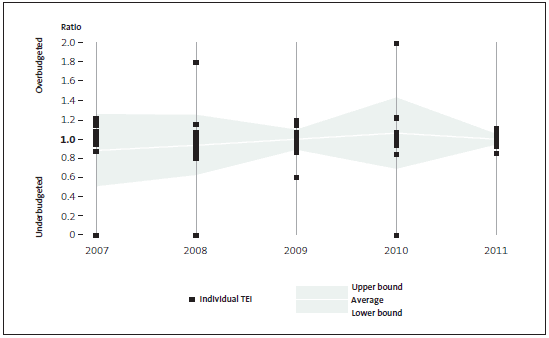
Budget to actual cash flows for capital expenditure
2.59
Figure 2 compares TEIs' actual capital expenditure with what was originally budgeted. A ratio of 1.0 indicates accurate budgeting.
Figure 2
Accuracy of budgeting for capital expenditure
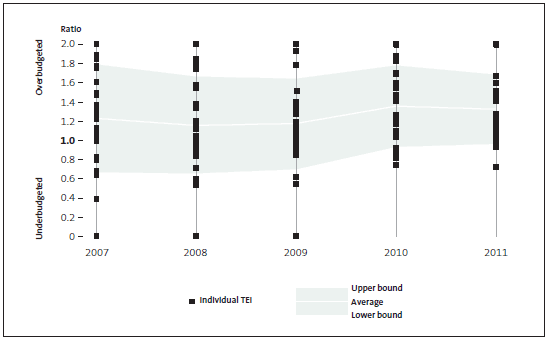
What the graphs show about stability
2.60
TEIs' ability to plan and budget for operational activities is satisfactory but has varied during the five years shown in Figure 1. The result for 2011 showed good accuracy in budgeting and considerably less variability between TEIs than in most other years.
2.61
However, TEIs consistently budgeted more than they needed for capital expenditure. Many of the TEI cash flow statements show the surplus being used to acquire other investments and financial assets or to cover variances in other areas.
2.62
Several TEIs showed a consistent pattern of significant over-budgeting in their capital expenditure activities.
The resilience of TEIs
2.63
We used three ratios to illustrate the capability of TEIs to respond to unexpected events without major structural or organisational change. These are:
- current assets to operating cash flows;
- current assets to current liabilities; and
- fixed costs to operating and capital cash flows.
Current assets to operating cash flows
2.64
Figure 3 shows how long the operational cash flows of TEIs could be supported using only current assets as funding. A ratio of 1.0 indicates that current assets would cover one year of operating cash flows.
Figure 3
Potential to use current assets for operating costs

Note: A ratio of 2 equates to 24 months, 1.5 to 18 months, 1 to 12 months, and 0.5 to six months.
Current assets to current liabilities
2.65
Figure 4 shows whether TEIs' current assets can cover their current liabilities. A ratio of 1.0 indicates that current assets would cover the value of current liabilities.
Figure 4
Potential for current assets to cover current liabilities
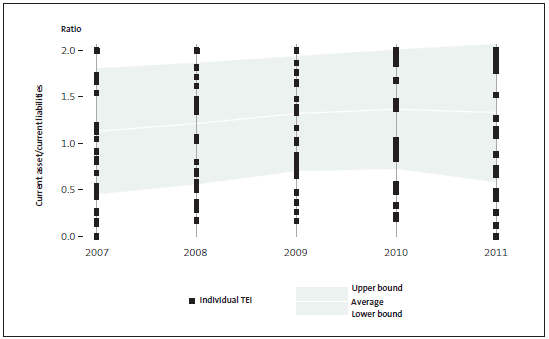
Fixed costs to operating and capital cash flows
2.66
Figure 5 shows the flexibility of TEIs' cost structure and ability to change in response to changing circumstances. A ratio of 1.0 indicates that all operating costs are fixed and not easily changed.
Figure 5
Level of fixed costs

What the graphs show about resilience
2.67
TEIs' capability to respond to unexpected events is supported by reasonable levels of current assets and current liabilities. As a sector, current assets cover about half a year's operating cash flows and working capital is positive and increasing.
2.68
However, many TEIs showed very high or very low working capital (outside what we would consider normal), and, for several, there was a consistent pattern over time. Furthermore, the levels of fixed costs are also reasonably high and variable throughout the sector. In 2010, fixed costs averaged 78% of operating and capital flows but declined to 62% in 2011.
The sustainability of TEIs
2.69
We used three ratios to show longer-term uncertainties and TEIs' ability to deal with them. These are:
- total debt to total assets;
- total liabilities to total assets; and
- capital expenditure to depreciation.
Total debt to total assets
2.70
Figure 6 shows whether the value of TEIs' assets would cover the value of their debt. The lower the ratio, the easier it is for a TEI's assets to cover its debts.
Figure 6
Level of debt compared to assets
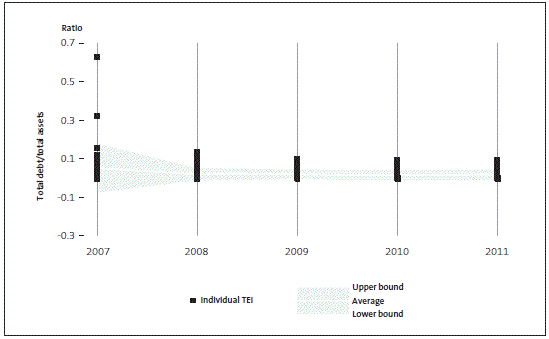
Total liabilities to total assets
2.71
Figure 7 shows whether the value of TEIs' assets would cover the value of their liabilities. The lower the ratio, the easier it is for a TEI's assets to cover its liabilities.
Figure 7
Value of total liabilities to value of total assets
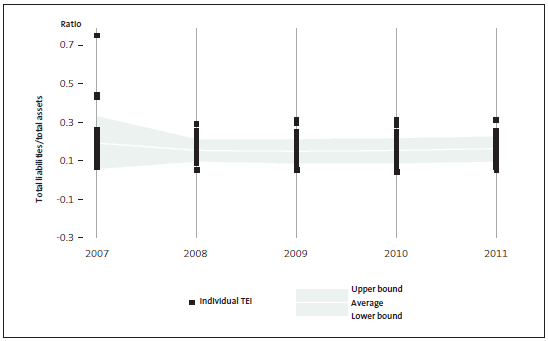
Capital expenditure to depreciation
2.72
Figure 8 shows the amount of capital expenditure required to maintain the existing asset base. Depreciation is assumed to be a reasonable estimate of the amount of capital expenditure needed to maintain the existing asset base. A ratio of 1.0 or above supports sustainability.13
Figure 8
Capital expenditure compared with depreciation
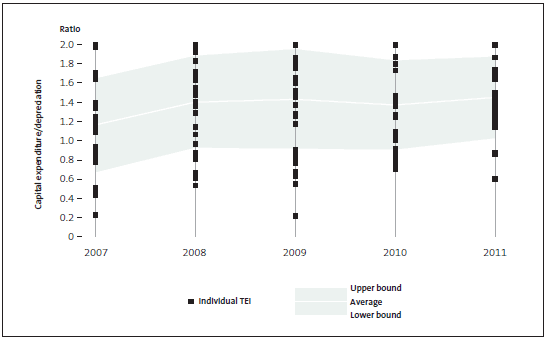
What the graphs show about sustainability
2.73
Our findings indicate that TEIs are capable of managing longer-term uncertainties with relatively low levels of debt and total liabilities (many TEIs have no debt at all, and the average debt level is declining).
2.74
Capital expenditure levels are also above depreciation estimates, which supports sustainability. It is less clear whether this is enough to maintain the existing asset base, because spending on new assets is not listed separately in the financial statements.
2.75
Finally, about 30% of the TEIs showed a ratio of capital expenditure to depreciation that was consistently outside what we would consider normal for the sector. This suggests a variety of assets and/or asset management practices in the sector.
4: See Part 2 of the Tertiary Education Strategy 2010–2015 on the Ministry of Education website, www.minedu.govt.nz.
5: See www.ssc.govt.nz/better-public-services.
6: In New Zealand's qualifications framework, levels 1 to 4 are certificates. Levels 5 and 6 are diplomas. Level 7 is Bachelors' degrees and graduate diplomas and certificates. Level 8 is post-graduate diplomas and certificates and Bachelors' degrees with Honours. Level 9 is a Masters' degree, and level 10 is a doctorate.
7: In 2011, Tairawhiti Polytechnic merged with the Eastern Institute of Technology, and Telford Rural Polytechnic with Lincoln University. The latter merger significantly affected Lincoln's 2011 EPI results.
8: Based on the TEC's data from its 2012 capital intentions returns from TEIs.
9: Anecdotal feedback from TEIs is that capital expenditure intentions tend to be moderated annually by TEI councils.
10: We used the financial data that relates to the TEI's own activities and not the consolidated activities of all its subsidiaries. There was a small amount of financial statement information that we could not collect for some TEIs. Because the analysis is sector-wide, we do not consider that this affects our overall findings.
11: For simplicity, we use the terms "risk" and "uncertainty" interchangeably to mean the potential for variation. In a public entity, a large operating surplus is as much an indicator of potential uncertainty (or risk) as a large operating deficit.
12: We use a standardised measure of variation on either side of the average to assess what is normal (in other words, plus and minus one standard deviation). Statistically speaking, this assumes a regularity that may not always be correct. Furthermore, to help reduce the effect of outliers that vary greatly from the average (for example, where zero is part of a ratio) we have capped the indicator's values at zero and two.
13: However, because capital expenditure also includes spending on new assets, we expect the ratio to be above 1.0 (possibly well above 1.0) in growing sectors.
page top
